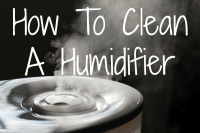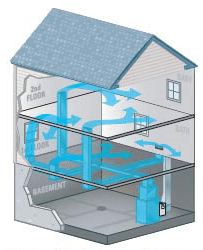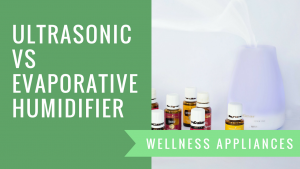Winter and its dryness from your heating system can affect your health and everything in your home. Hair can be unmanageable and full of static, hands become dry and cracked, nasal passages become dry and bleed, and wood furniture cracks and dries out. With a humidifier, you can put moisture into your home to rid yourself of these conditions and add moisture for your health.
You’ve been running your humidifier for some time now and it needs to be cleaned. This is a must-do for keeping your humidifier in top-notch condition so that microbes and bacteria contamination does not occur.
Three Types of Whole-House Humidifiers
Each has a specific way to clean and the manufacturer’s instructions or Owner’s Manual is the best place to start. A whole-house humidifier attached to your furnace or air handler adds water vapor to your house. The standalone (portable and tabletop) humidifiers are used in usually one room and moved from place to place as needed.
- Drum (reservoir type)
- Flow-through (drip type)
- Steam type
The drum humidifiers with a tank (reservoir) for holding water use a drum that rotates with a pad of foam, or similar, that sucks up water from a float in the water tank to evaporate the water for putting into the air. This unit requires more maintenance.
The flow-through drip humidifier contains a coated metal or plastic screen that has water constantly dripping across the surface of the screen and when the furnace runs puts humidity into the air. This unit requires more maintenance.
Being the most expensive, the steam units contain heaters to make steam requiring the least amount of maintenance. It attaches to the furnace, requires water to operate, and is the most efficient. This unit might need a filtration system depending on the water hardness.
Maintenance Tips
- Drum—the foam pad will harden from hard water minerals and sediment from the tap or well water losing its ability to absorb and be effective. The water reservoir can become stagnant, become a breeding place for pathogens, and mold causing illness. The foam pad (or similar) must be cleaned each month and replaced each year.
- Flow-through—uses a coated metal or plastic evaporator pad to put moisture into the air. These units are controlled with a humidistat. They stay cleaner better than the drum type not being as disposed to bacteria and mold growth. They are very reliable and efficient. Consult your Owner’s Manual for routine maintenance.
- Steam—has a self-generating steam heater. The tank should be cleaned every 5 months, but check your specific humidifier brand for instructions in the User’s Manual. The mineral deposits must be removed that are in the tank. It is easy to empty and remove the water then clean out the inside of the tank. With hard water, you might need to do it more often. Some models have a ‘Cleaning Required’ light to let you know it is cleaning time.
Check for Leaks
If your humidifier is leaking on the floor, be sure to turn the water supply line off. Determine what is causing the leak and repair it. Water bills can go up substantially with leaks.
Stand-Alone Humidifiers
Portable and tabletop humidifiers are necessary during cold weather. These easy-to-move units are great for a student living in the dorm and for apartment and home renters who have no need to invest in a whole-house humidifier. Most portable humidifiers are inexpensive from about $20 upwards to $100.
Features and Performance
Purchase a humidifier that is easy to fill, easy to carry, and easy to replace its filter or wick. Remember that humidifier maintenance is important. The smaller humidifiers, sometimes called vaporizers, can only work efficiently in one room or perhaps a few small rooms at best.
Clean for Health
You should have no worries about health problems when you follow your manufacturer’s instructions that came with the User’s Manual. You want to dump leftover water after each use. Clean and disinfect the water tank after each use. This lets you and your child and family rest assured they are not breathing in contaminated water mist full of germs and bacteria, mold and mildew.
What to Use and How to Clean

To have the right humidity level in your room, the mist has to first come out. It cannot vaporize properly if the unit is full of gunk—minerals from hard water. You will want to maintain it frequently; it is easy and takes very little time. You want to remove any hard water scale (mineral deposits) and have no organisms growing in the water. Manufacturer’s generally state hard water is fine to use. It is not. Distilled water is the best to use so there will be no mineral deposits inside the tank.
Water Tank Cleaning
- Turn the power switch to off. Unplug the humidifier from the outlet so that there is no potential for a shock.
- Carefully remove the water tank and dump out the water.
- Add one tablespoon of bleach to the water tank and fill up with cool tap water. You do not need distilled water for this task because it will be dumped. You can also use clear distilled vinegar. Use one quarter of a cup of vinegar to the tank no matter what size and fill with water.
- Put the cap back on the water tank and tighten. Turn the tank upside down several times to mix the bleach or vinegar and water. Allow this mixture to stand for 10-20 minutes.
- Dump the solution out and rinse the tank several times with cool water until you can no longer smell the bleach or vinegar. Wipe the outside clean as well as the unit itself. Dry with a soft towel.
Cleaning the Filter Cover and Base
- Check your User’s Manual to determine if the filter(s) are washable. If not, replace with the spare filters you have on hand—you do, right? If the filter is washable, wash or clean it as the instruction manual states.
- Remove the filter and clean the outside filter cover with a damp cloth or the bleach/vinegar solution if needed. Do not get any water into the motor unit or wiring. Wipe away any dust from the inside.
- Use a mix of half tap water and half distilled clear vinegar and put in the base. Allow it to soak for 5 minutes or so and clean with a brush or soft cloth.
- Rinse with cool tap water until the vinegar smell is gone.
- Put the unit back together making sure it is thoroughly dry. Plug back into the outlet and you are ready to use it again.
Caution: Do not submerge the motor part in water. Do not mix bleach with ammonia to clean because these chemicals produce dangerous vapors that are harmful to breathe in.
Cleaning your humidifier is really a breeze. With proper maintenance, it will last for years.




